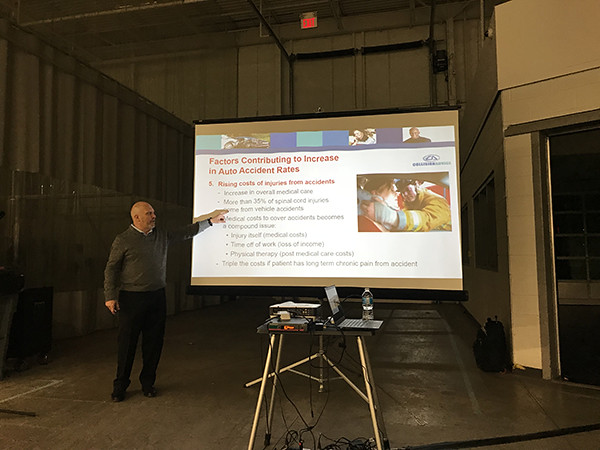By Tom Davis
Vaughan, Ontario — November 16, 2017 — Telematics will completely change the way collision repairers operate their business. That’s the claim of industry stalwart Mike Anderson of Collision Advice, speaking at the Pfaff Open House event on November 15. He adds: “Autonomous vehicles make for good news but are ‘not the priority’ for OEMs.”
Anderson cited a 2014 study from the World Health Organization (WHO), which found 1.24 million people die in traffic accidents each year. It predicted that automobile accidents would be the fifth leading cause of death by 2030. What the study predicted would take 15 years to be reached actually occurred in three years. Automobile accidents were the fourth highest cause of deaths in the US in 2016.
As a result, Anderson said OEMs have four priorities: preventing fatalities; minimizing bodily injuries; improving fuel economy and creating safety and comfort features.
This is being done through the advent of telematics. Telematics, which gives a vehicle real-time alerts and diagnostic information, can cut down on first responders’ time and in return reduce the severity of vehicle accident injuries.
Telematics features include accident avoidance technology, accident response, claims investigation, as well as theft and fraud deterrence. The technology allows OEMs to be notified when a vehicle is in an accident and further enables them to refer the driver to a repair shop in real-time.
Anderson said it’s not a case of if this will be introduced to the market, but when. A generational shift will be vital to this, as well as the affordability of vehicles that use the technology, he claimed. Insurers are likely to offer incentives for drivers willing to be monitored through new technology.
These new technologies will change the business, and OEM manufacturers will become key. An example of this is Toyota’s luxury vehicle division Lexus, which will require repairers to input a VIN number into the OEM manufacturer website and deactivate it. If the repairer does not deactivate the VIN, the consumer will receive emails that their car is damaged for each change the shop makes.
Telematics has made even simple repairs more complicated, said Anderson. There are now things that repairers need to do when simply changing a battery. If a repairer doesn’t follow OEM recommendations for each repair it will now be liable for future issues.
He cited the John Eagle collision case, stating liability will always transfer after a repair even if the car is sold to a new owner. “Following the OEM recommendation is vital, he said. “Not meeting recommendations is negligence.”
Repairers will also need to learn how to repair electric vehicles. He said: “Electric vehicles will be the diesel of the future. You will see more electric and hybrid vehicles in the future and everything we’ve had to learn about repairing aluminium is coming with electric vehicles.”
Various OEMs have released bulletins on electric vehicles and painting booths – for all vehicles there is a temperature limit they can be exposed to. This will completely change painting technology, Anderson said.
He also pointed to the fact that OEMs have symbols for parts that need to be replaced – not repaired. It’s more important than ever before to follow OEM recommendations. He commented: “As you move forward it’s important to learn about OEM repair procedures.”
“Learn to research OEM repair procedures, and then research OEM procedures to learn how to do repair procedures property,” Anderson finished.
The annual open house was created by Jeff Pabst, General Manager of Pfaff Autoworks Vaughan site, in a bid to bring together the repairers, insurers and OEMs. The event’s end goal is to bring all three parties together and encourage them to work towards a common goal of the consumer, by way of repairing cars to OEM specifications. “This will ensure a safe repair in an economical process”, said Pabst.
Introducing the event, he said: “This annual event stemmed from an idea I had about inviting the insurance industry into our bodyshop and educating them about the way we operate and how we can communicate more moving forward.”
Anderson’s talk was followed by demonstrations and further break-off talks from OEMs and suppliers. These talks included presentations from Greg Aguilera at Porsche Canada, Scott Wideman from Volkwagen Group Canada, Matt Bannister of Titanium and Dave Flockhart of BeTAG Innovation. John Norris of Ontario College of Trades was also in attendance.
Gary Lin, of BMW Canada, also presented at the open house. Speaking of the event he said: “This allows participants to have hands on experience on how our vehicles are repaired and returned to the safety specifications which BMW Group engineers had defined when the vehicles were originally built.”
Larry Miller, Vice-President of Business Development and Operations at Verifacts Canada also attended the event. He introduced the audience to Verifacts and its aim for the Canadian market.
More information about Pfaff Autoworks can be found at pfaffautoworks.com.










































